Discovering commonly used battery types in electronic projects
In our modern world, batteries are the lifeblood that powers our everyday devices. When it comes to radio control, toys, and electronic projects, choosing the right battery is essential for an uninterrupted and enjoyable experience. By understanding the features, advantages, and applications of these batteries, you can make informed decisions and maximize the performance and enjoyment of your devices. In this article, we will explore some commonly used battery types in these realms.
Alkaline batteries
Alkaline batteries, while not rechargeable, remain a common choice for many devices due to their availability and convenience. These batteries are cost-effective, widely accessible, and come in various sizes and voltages. Alkaline batteries provide reliable power for low-drain devices. They have a long shelf life and can be easily replaced when depleted. However, it's important to note that using disposable batteries in high-drain applications may result in frequent replacements and increased waste.
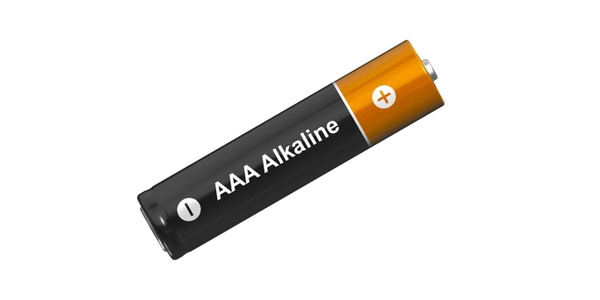
Pros of Alkaline:
Alkaline batteries, known for their wide availability, can be found in numerous stores and are offered in various sizes and voltage options. This widespread availability makes them easily accessible for immediate replacement when needed.
One of the notable advantages of alkaline batteries is their long shelf life. They have the capability to retain their charge for an extended period, even when stored unused. This characteristic ensures that alkaline batteries remain reliable and ready to use whenever required.
In terms of cost-effectiveness, alkaline batteries offer an affordable solution, particularly for low-drain devices that do not demand frequent battery changes. Their suitability for such applications makes them an economical choice without compromising performance or longevity.
Cons of Alkaline:
While alkaline batteries are widely available and convenient for immediate replacement, it's important to note that they are disposable and cannot be recharged. This characteristic contributes to increased waste and ongoing replacement costs, as new batteries must be purchased each time.
The disposal of alkaline batteries can have environmental implications. These batteries contain heavy metals such as mercury and cadmium, which, if not properly handled during disposal, can potentially contaminate soil and water sources. Responsible disposal methods and recycling programs are essential to mitigate these environmental risks.
Alkaline batteries have a lower capacity compared to rechargeable battery types, which may result in shorter runtimes for devices with higher power demands.
Li-ion batteries
Lithium batteries have become increasingly popular in recent years, revolutionizing the way we power electronic devices. Known for their high energy density, long cycle life, and lightweight construction, lithium batteries have found their way into various applications, from smartphones and laptops to electric vehicles and renewable energy storage systems.
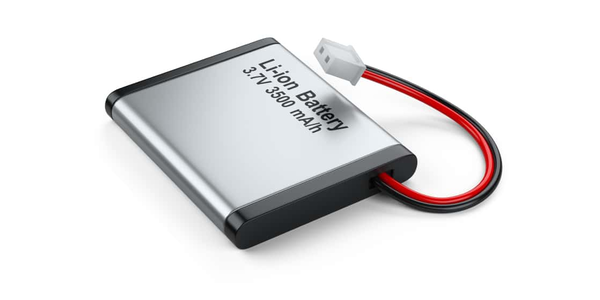
Pros of Li-ion
Lithium batteries offer a significantly higher energy density compared to other rechargeable battery types. This means they can store more energy in a smaller and lighter package, making them an excellent choice for portable electronic devices where size and weight are crucial considerations.
One of the notable advantages of lithium batteries is their extended lifespan and ability to endure a greater number of charge-discharge cycles when compared to many other batteries. This longevity ensures that devices powered by lithium batteries can be utilized over an extended period without experiencing significant capacity degradation.
An advantageous feature of lithium batteries is their ability to charge at a faster rate than many other rechargeable batteries. This capability reduces the time required to replenish the battery's charge, enabling a quick turnaround and uninterrupted use of devices. This feature proves particularly useful in scenarios where devices need to be ready for use promptly.
Cons of Li-ion:
Lithium batteries, while offering exceptional performance, can be sensitive to mishandling, overcharging, or exposure to extreme temperatures. In rare instances, these conditions can lead to thermal runaway, resulting in the battery overheating or even catching fire. To minimize safety risks, it is crucial to adhere to proper storage, charging, and handling practices when using lithium batteries.
Lithium batteries contain toxic materials, including lithium, which can be harmful to the environment if not disposed of properly. Additionally, the extraction and processing of lithium can have adverse environmental consequences. Recycling programs and responsible disposal methods are important to mitigate these impacts.
Compared to other battery types, lithium batteries can be more expensive. The higher cost is due to factors such as the complex manufacturing process and the use of materials like lithium cobalt oxide or lithium iron phosphate, which contribute to their superior performance. However, as technology advances and the adoption of lithium batteries increases, their cost has been gradually decreasing over time.
Ni-MH batteries
Nickel-Metal Hydride batteries have been a popular and cost-effective option for powering radio control vehicles, toys, and electronic projects. They are rechargeable and provide a higher capacity compared to traditional alkaline batteries. Ni-MH batteries come in various sizes and voltage options, making them compatible with a wide range of devices. They are also less prone to memory effect and offer a decent shelf life. Their overall balance between cost, performance, and safety makes them a reliable choice for hobbyists and enthusiasts.
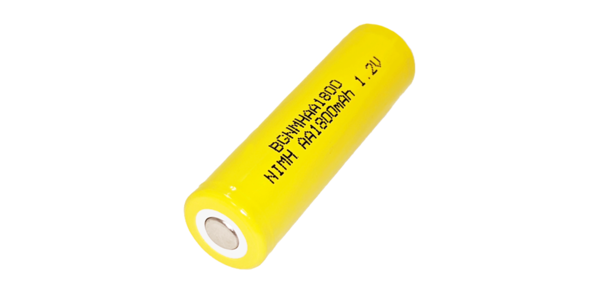
Pros of Ni-MH:
Ni-MH batteries present a cost-effective and environmentally friendly solution due to their reusability. These batteries can be recharged numerous times, making them a sustainable choice in the long run. By opting for Ni-MH batteries, users can save money on frequent battery replacements while also reducing waste.
Compared to traditional alkaline batteries, Ni-MH batteries offer a higher capacity. This increased capacity translates to longer runtimes, allowing devices to operate for extended periods without the need for frequent battery changes. Whether it's powering electronic toys, portable radios, or other energy-demanding devices, Ni-MH batteries provide a reliable and long-lasting power source.
Ni-MH batteries come in various sizes and voltage options, allowing compatibility with a wide range of devices and applications. This flexibility allows users to find the right Ni-MH battery to match their specific needs, ensuring compatibility and optimal performance.
Cons of Ni-MH:
Ni-MH batteries tend to self-discharge over time, meaning they lose charge even when not in use. To ensure their optimal performance, regular recharging or appropriate storage techniques are necessary.
In terms of energy density, Ni-MH batteries have a relatively lower capacity compared to certain other battery types. This characteristic translates into a larger physical size requirement to achieve the same capacity level. It's important to consider this factor when space constraints are a concern.
While Ni-MH batteries are less susceptible to memory effect compared to older battery technologies, they can still experience some memory effect if not properly cycled or maintained. This occurrence can lead to a reduction in usable capacity, potentially affecting the overall performance of the battery. Proper cycling and maintenance practices are essential to minimize the impact of memory effect on Ni-MH batteries.
LiPo batteries
Lithium Polymer batteries have gained significant popularity in recent years, especially in the radio control and hobbyist communities. LiPo batteries offer high energy density, lightweight construction, and the ability to provide high discharge rates. They come in various configurations, including multiple cells connected in series (2S, 3S, 4S, etc.), enabling higher voltages. LiPo batteries are known for their exceptional power-to-weight ratio, making them ideal for high-performance applications such as drones, RC planes, and racing cars. However, it's crucial to handle LiPo batteries with care, as improper charging, storage, or handling can lead to safety risks.
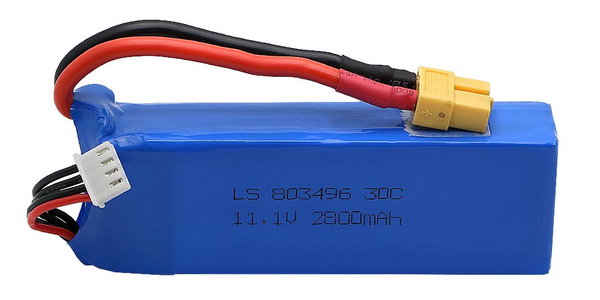
Pros of LiPo:
LiPo batteries offer an exceptional energy density, allowing for lightweight and compact designs. This advantageous feature permits the development of portable and space-efficient devices without compromising on performance.
One of the notable strengths of LiPo batteries is their ability to deliver high discharge rates. This quality makes them particularly well-suited for applications that necessitate bursts of power or have high-performance demands. Whether it's propelling remote-controlled vehicles at high speeds or supplying energy to drones during intense maneuvers, LiPo batteries excel in delivering the required power efficiently and reliably.
LiPo batteries can be easily connected in series (2S, 3S, 4S, etc.), providing flexible voltage options to match the requirements of different devices and projects.
Cons of LiPo:
LiPo batteries demand careful handling and proper charging techniques due to their high sensitivity. Mishandling or improper charging can lead to hazardous situations such as overheating, swelling, or even fire. It is essential to adhere to strict storage protocols, handle them with care, and follow recommended charging practices to ensure safety.
Over time, these batteries may experience degradation, especially when subjected to high discharge rates or extreme temperatures. It is crucial to be mindful of these factors to prolong the lifespan and maintain optimal performance.
In terms of cost, LiPo batteries can be relatively more expensive compared to other battery types. The investment in LiPo batteries extends beyond the cells themselves, as additional accessories like balance chargers and fireproof storage bags are often necessary for safe and efficient use.
Ni-Cd batteries
Although less prevalent today, Nickel-Cadmium batteries were once widely used in radio control systems and electronic hobby projects. Ni-Cd batteries are rechargeable and offer a relatively high discharge rate. They perform well in cold temperatures and are capable of delivering consistent power output. However, Ni-Cd batteries have a lower capacity compared to newer battery technologies, suffer from memory effect if not properly maintained, and contain toxic cadmium, making them less environmentally friendly.
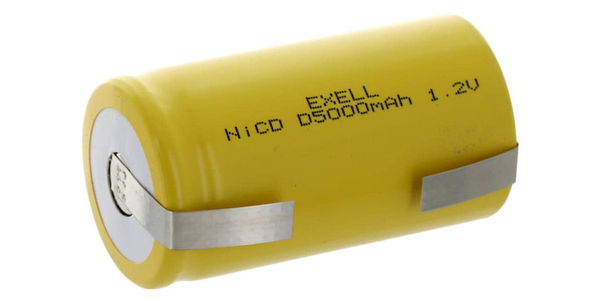
Pros of Ni-Cd:
Ni-Cd batteries are rechargeable, allowing for multiple cycles of use, making them a cost-effective choice in the long run.
Another strength of Ni-Cd batteries is their ability to deliver a high discharge rate. This makes them well-suited for applications that require quick bursts of power or have high-performance demands.
Ni-Cd batteries perform well in cold temperatures, making them reliable in environments where other battery types may struggle.
Cons of Ni-Cd:
Ni-Cd batteries are susceptible to memory effect, a phenomenon where the battery "remembers" a shorter capacity if it is consistently discharged and recharged without being fully depleted. By ensuring periodic full discharges and recharges, users can minimize the impact of memory effect on Ni-Cd batteries, maintaining their maximum capacity and performance.
In terms of capacity, Ni-Cd batteries have a lower capacity compared to newer battery technologies available today. This characteristic may result in shorter runtimes for devices or the need for more frequent recharging. It is important to consider the specific power requirements of the application and evaluate whether the capacity of Ni-Cd batteries aligns with the desired usage time and performance.
Ni-Cd batteries contain toxic cadmium, which poses environmental risks if not disposed of properly. The use of Ni-Cd batteries has been reduced in recent years due to the availability of more environmentally friendly alternatives, such as Ni-MH and lithium-ion batteries.
Conclusion
When it comes to electronic projects, choosing the right battery type is crucial for optimal performance, longevity, and environmental sustainability. Whether it's the versatility of Nickel-Metal Hydride (Ni-MH) batteries, the high energy density of Lithium Polymer (LiPo) batteries, or the convenience of alkaline batteries, each option offers its own set of advantages and considerations. By carefully considering factors such as capacity, rechargeability, safety, and environmental impact, we can make informed decisions that align with our project requirements.

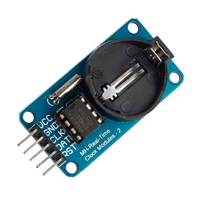
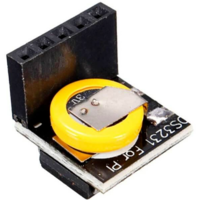

0 Comments